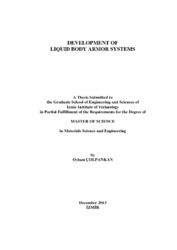Please use this identifier to cite or link to this item:
https://hdl.handle.net/11147/3680Full metadata record
| DC Field | Value | Language |
|---|---|---|
| dc.contributor.advisor | Tanoğlu, Metin | en |
| dc.contributor.author | Çolpankan, Oylum | - |
| dc.date.accessioned | 2014-07-22T13:52:08Z | - |
| dc.date.available | 2014-07-22T13:52:08Z | - |
| dc.date.issued | 2013 | en |
| dc.identifier.uri | http://hdl.handle.net/11147/3680 | - |
| dc.description | Thesis (Master)--Izmir Institute of Technology, Materials Science and Engineering, Izmir, 2013 | en |
| dc.description | Includes bibliographical references (laves: 93-98) | en |
| dc.description | Text in English; Abstract: Turkish and English | en |
| dc.description | xvi, 98 leaves | en |
| dc.description | Full text release delayed at author's request until 2017.01.15 | en |
| dc.description.abstract | Body armors consist of fabrics made of high performance fibers which are characterized by low density, high strength, high tenacity and high energy absorption. Soft body armors are produced with lamination of 20-50 layers of fabrics and hard body armors consist of ceramic/metal plates along with the fabric. However, these armors are bulky, heavy, non-flexible. In order to eliminate disadvantages of traditional armors, new armor concept has been come into use with impregnation of shear thickening fluids (STFs) onto soft body armors called as liquid body armors. STFs are used within the fabrics to improve the ballistic and stab resistances due to its flowable behavior under ordinary conditions and become a rigid solid when a strong impact is applied. Objective of this study is to develop flexible, lightweight and high protection level soft body armors with the impregnation of shear thickening fluids onto fabrics. In this study, for the production of STFs, colloidal and fumed silica nanoparticles were employed. As the carrier fluid polyethylene glycols (PEG) with three different molecular weights were used. The STFs were prepared by sonication of nanoparticles within the carrier fluid. The rheological behaviours of STFs were investigated using a rheometer. Two types of composites were fabricated by impregnating of STFs onto aramid and UHMWPE mat fabrics. The stab resistances (quasi-static and dynamic), flexibility and ballistic features of composites were tested and compared with neat fabrics. The microstructural surface coating features of STF and composites were also characterized by using scanning electron microscope (SEM). | en |
| dc.language.iso | en | en_US |
| dc.publisher | Izmir Institute of Technology | en |
| dc.rights | info:eu-repo/semantics/openAccess | en_US |
| dc.subject.lcsh | Body armor | en |
| dc.subject.lcsh | Armor | en |
| dc.subject.lcsh | Polymers | en |
| dc.title | Development of liquid body armor systems | en_US |
| dc.type | Master Thesis | en_US |
| dc.institutionauthor | Çolpankan, Oylum | - |
| dc.department | Thesis (Master)--İzmir Institute of Technology, Materials Science and Engineering | en_US |
| dc.relation.publicationcategory | Tez | en_US |
| item.languageiso639-1 | en | - |
| item.fulltext | With Fulltext | - |
| item.openairecristype | http://purl.org/coar/resource_type/c_18cf | - |
| item.openairetype | Master Thesis | - |
| item.grantfulltext | open | - |
| item.cerifentitytype | Publications | - |
| Appears in Collections: | Master Degree / Yüksek Lisans Tezleri | |
Files in This Item:
| File | Description | Size | Format | |
|---|---|---|---|---|
| 10013595.pdf | MasterThesis | 5.01 MB | Adobe PDF |  View/Open |
CORE Recommender
Page view(s)
116
checked on Jul 22, 2024
Download(s)
166
checked on Jul 22, 2024
Google ScholarTM
Check
Items in GCRIS Repository are protected by copyright, with all rights reserved, unless otherwise indicated.